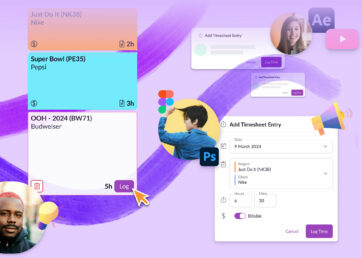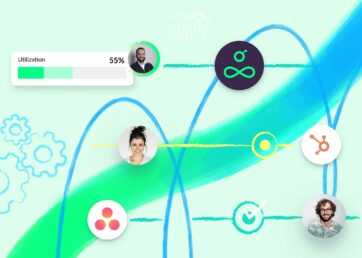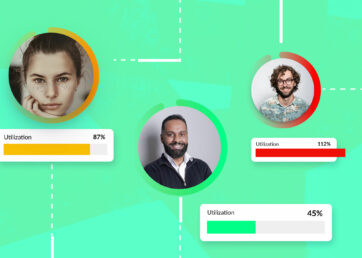There’s work and then there’s all the tasks that go into making that work possible: soliciting feedback, fielding approvals, sitting in meetings, and sometimes Slacking your colleagues to align on a project.
The problem is that when there are no agency processes in place, and your team isn’t organized properly, the latter tends to take up a lot of time, and may make up more of your day than is spent on your client-facing projects.
When it comes to efficiency, the structure and operations of most agencies don’t set workers up for success. The result is that you may be left scrambling to meet tight deadlines, without the resources you need to make your work shine. Enter the realm of agency processes—an essential way that you can win back your time.
To add expert perspective, we spoke with:
- Bruno Rodriguez, Head of Organic at the digital marketing agency Orange Line
- Matthew Anderson, Founder of Tonicfox, a consultancy designed to help agencies manage growth and change
They are quoted throughout the article with specific tips and tricks for process optimization.
In this article 📖
What is an agency process?
“Agency process” refers to the established framework and procedures that an organization uses to reach its goals. Processes touch a number of different aspects of work including:
- Key stakeholders responsible for meeting a goal
- Roles and responsibilities across teams
- What technology to use
- How progress is documented
- Expectations for communication and updates
- How goals are measured and tracked
Processes tend to be broader than agency workflows, which are a set of steps that bring a project from initiation to completion. While workflows help you push a specific common function or task to the finish line, agency processes provide the structure that will allow your agency to reach its larger, organizational goals.
Agencies may have processes to help manage:
- Resource Management
- Project management
- Client onboarding
- Sales
- Pitching & RFPs
- Account management
- Planning
- Production
- Reporting
- Briefing
Specific types of agencies also have processes tailored to their unique work.
Benefits of agency processes
Have you ever had to give someone way too many “friendly reminders” to get that last approval on your project? Or spent an entire week badgering IT to give you access to the software you need to do your job? If the answer is yes, then you already know the value of agency processes.
When an agency has clear processes, you’re able to spend less time thinking about how to get your work done, and more time pushing projects forward.
Without these guiding frameworks, agencies become vulnerable to:
- Disorganized ways of working that delay progress
- Missed deadlines
- Burnout of agency employees
- Decreased efficiencies generally
All of these things cost agencies clients and money.
4 steps to developing an agency process flow
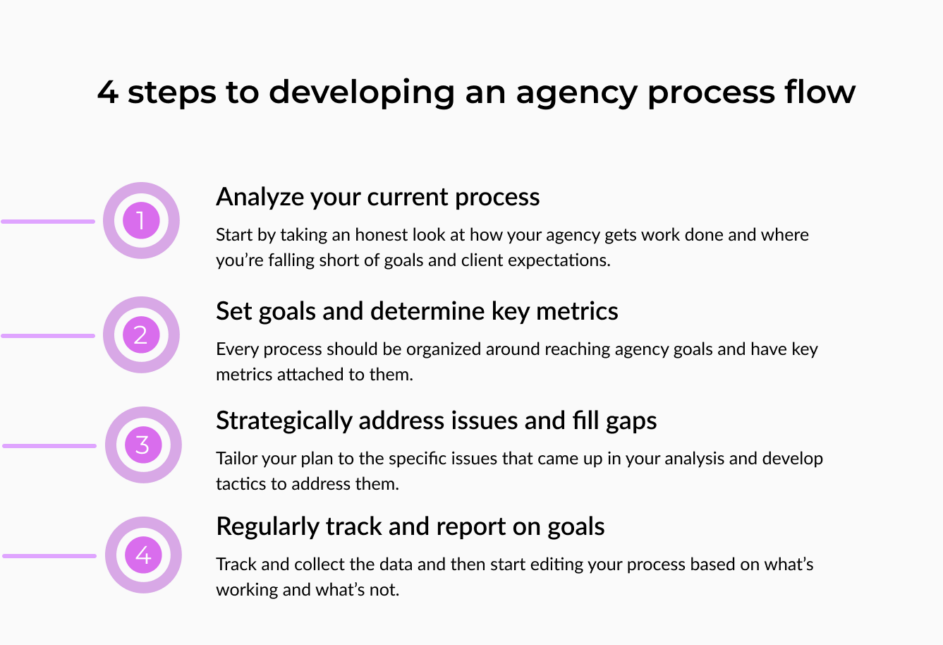
So, what’s the process for building a process? The steps below provide a roadmap you can use to build new ways of working at your agency.
1. Analyze your current process
To create a great process, start by taking an honest look at how your agency gets work done and where you’re falling short of goals. Dig into the data. If you want to retain more leads, can you figure out where people are currently falling off? If there are issues with client onboarding, can you look back at past surveys to find common complaints?
You’ll also want to see if there are any glaring process issues that people at your agency experience day-to-day. An agency resource management tool, like Resource Guru, can be helpful here for getting reports on where teams are spending their time.
Lastly, you’ll want to talk to your colleagues directly. Most people will be happy to share the obstacles and blockers that prevent them from doing their best work
2. Set goals and key metrics
When developing a process, keep your eye on the prize. Every process should be organized around reaching agency goals. These goals should also be measurable so that you’re able to track whether or not your process is actually effective. Using a metric-focused goal-setting method like OKRs or KPIs is helpful for this.
4. Strategically address issues and fill gaps
From here, you’ll want to tailor your plan to the specific issues that arose in your analysis. In order to spark some ideas, we’ll list some common process issues here with strategies for how to tackle them.
Employees are burned out and there’s still a backlog of work
The problem: You can’t produce the best work for your clients if you’re burnt out and overwhelmed. This culture can also result in high turnover at your agency, which will set work back even further.
“The best processes in the world won’t save a company where people don’t stay for longer than a year, but good professionals who stay for long periods of time will generally internalize processes and contribute to them over their time at an agency,” Bruno said.
The solution: Re-examine the priorities that you and your colleagues are working on. If you’re not already using a resource management tool, consider introducing one to track how much capacity people have and how much of their time is going to billable work. As you draft a process, use this data to figure out where time and energy can be saved.
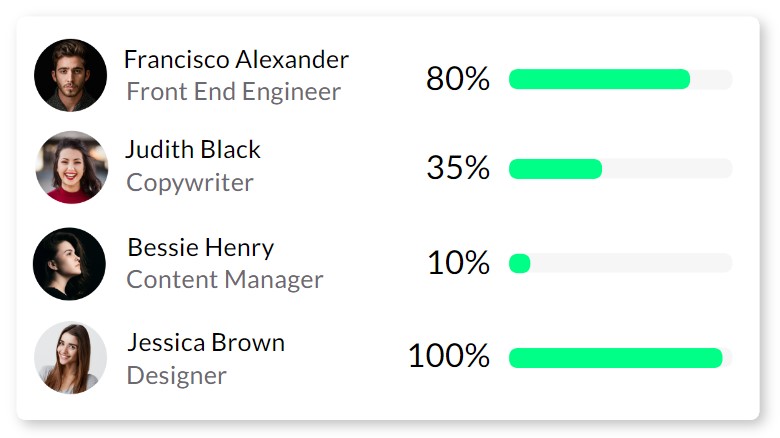
An example of how individual utilization rates appear in Resource Guru’s software.
In a process, this will look like:
- Eliminating high-effort, low-value work
- Automating administrative work wherever possible
- Balancing responsibilities across stakeholders
Lack of clarity on agency roles and responsibilities
The problem: According to Matthew, as agencies grow, it can lead to confusion on basic questions, like what needs to happen and who’s doing what.
The solution: Establish and communicate a clear definition of deliverables, and establish roles and responsibilities across the agency.
“This simplifies decision-making and allows everyone to focus on the things they really need to focus on, while removing themselves or concerning themselves less with things that are not essential for them,” Matthew said.
In a process, this will look like:
- Clearly assigning certain work to a particular individual or team
- Calling out core deliverables needed in the process
Work is taking too long to be approved
The problem: When your agency lacks process, it can be difficult to figure out who’s responsible for giving the final go-ahead on work. This can delay projects and it’s flat-out frustrating when you have to wrestle with bureaucracy for approvals.
The solution: Use a DACI framework to clearly define the driver, approver, contributors, and informed parties for your process. It’s important to limit the final approver to one person in order to prevent standstills.
In a process, this will look like:
- Building approvals into your procedures
- Requiring clear documentation of approvals
4. Regularly track and report on goals
The point of processes is to help you make progress on goals. To know if they’re working properly, you’ll need to keep an eye on key metrics as you implement them. Collect the data and then start editing your process according to what’s working and what’s not.
Best practices for agency process documentation
Once you’ve developed a strong process, documentation will help you motivate people across your agency to actually adopt and follow it. Documentation is also the only way to make sure that knowledge of the process stays within the company, even as individual employees come and go. It will allow agile agency processes
There are a few steps you can take as you write and format your documentation that will point you in the right direction.
1. Make your documentation accessible
Your process documentation is only helpful if your stakeholders are able to find it. Make documentation accessible by:
- Storing it in a central place, like a shared folder that’s easy to find
- Making permissions to access the documentation flexible (where possible)
- Using plain, easy-to-understand language
2. Pick the most appropriate (and most concise) document formats
If your documentation is long and wordy, your busy stakeholders are unlikely to take the time to figure out its meaning. Instead, consider visual formats that clearly communicate processes but are lean on words, like a flowchart or checklist.
3. Regularly update your documentation
In order to remain effective, your processes and documentation should evolve alongside your agency. Set up quarterly meetings in your calendar to remind you to update documentation at least once every few months.
Introducing new agency processes
Change can be hard and your colleagues may not be eager to learn a whole new way to work. It’s important that you introduce your agency process in a way that will motivate people across your agency to get on board.
Matthew stressed that it’s particularly important to get buy-in from leadership, “If you don’t have the support of everyone who will be enforcing how things are done, your process is likely to die a slow death of limited adoption.”
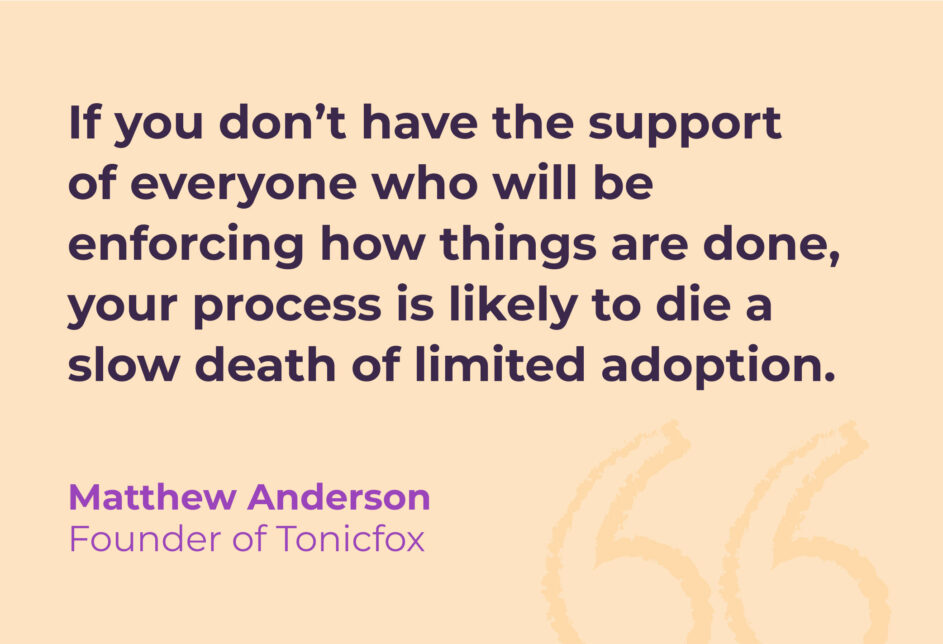
Take a collaborative approach
To create processes that your colleagues actually want to use, ask them to get involved in crafting them. According to Bruno, people are more likely to respect processes if they’re involved in developing them because it helps them to understand the problems that are being solved.
Focus on the goal of the process
You’ll also want to ensure that stakeholders are aware of why the new processes are being developed in the first place. Clearly communicate how your new processes will push you toward agency goals. Present data that stresses why these changes are important.
Provide training
You can’t expect people to adapt to a totally new way of working overnight. Matthew believes that training is critical when a process is first introduced and also as it changes over time.
“I’ve made mistakes in the past where we roll something out and then do an initial training, but then fail to retrain, keep updates coming in, or dedicate a resource where the team’s questions can be answered quickly,” Matthew said.
Building processes for different types of agencies
The tips above are helpful when it comes to building a process for agencies in general. But how should you approach creating processes that are tailored to your specific agency? Below we’ll cover processes to get started with and key things to consider across different types of agencies.
Advertising agency process
Processes may include:
- Creative research
- Creative development
- Media buying
Important call-outs: Ad agencies need to quickly adapt to new trends to stay relevant. It’s important that flexibility is built into their ad agency processes to allow teams to pivot creative and media buying strategies at the last minute.
Branding agency process
Processes may include:
- Brand discovery
- Brand strategy research
- Design
- Brand rollout
- Content creation
Important call-outs: A successful brand is more than just visuals—it’s a holistic representation of an organization’s values and emotions. The elusive nature of these agencies’ work may make it difficult to break brand development into a definitive structure. It’s important to remember that the best creative processes allow the appropriate space for unstructured time, where creatives can brainstorm and ruminate to form great ideas.
Creative agency process
Processes may include:
- Creative research and competitive analysis
- Creative development
- Design
- Campaign launch
- Campaign management
Important call-outs: Matthew noted that creative agencies can often be the most resistant to the introduction of new processes due to a longstanding (and false) belief that process kills creativity. In fact, implementing clear processes can leave more room (and time) for creative thinking.
He prescribed that for creatives, it’s especially important to focus on the why of the process and to clearly communicate how the process is going to help their agency win.
Design agency process
Processes may include:
- Design briefing
- Design research and competitive analysis
- Design rollout
Important call-outs: Similar to branding and creative agencies, design agencies produce subjective work that often can’t be developed in a straightforward way. An effective process will strike the balance between streamlining work without restricting the creative process. As recommended above, this looks like building flexibility and appropriate brainstorming time into processes and working with creatives to ensure they don’t feel stifled by new procedures.
Digital marketing agency process
Processes may include:
- Social media strategy
- Content marketing
- SEO strategy
- Paid media strategy
- Product launches
Important call-outs: The duties of general digital marketing agencies tend to be very broad when compared to more specialized SEO agencies or media agencies. In agencies that oversee a variety of different types of work, it’s important that digital agency processes and marketing agency processes encourage cross-team communication so teams are able to produce work that is in alignment.
Media agency process
Processes may include:
- Media planning
- Media buying
- Campaign management
Important call-outs: According to Matthew, media agencies tend to be more willing to invest in building their business, since they’re used to working with large budgets. Because of this, they may be more motivated to introduce new processes. While other agencies may require greater persuasion when it comes to investing in new processes, especially around growth and pipeline management, you can typically think bigger and take more risks when it comes to proposing media agency processes.
SEO agency process
Processes may include:
- Keyword research
- Technical auditing
- Content Creation
- Tracking and reporting on organic traffic
Important call-outs: Bruno explained that because very few businesses outside of agencies are big enough to justify large SEO teams, many professionals in this industry are used to working alone or in small groups.
“This generates a disproportionate amount of SEO professionals who have little faith in processes, don’t understand their value, or don’t know how to implement and optimize them,” Bruno told us. But, with that said, a lean team may make process-driven efficiency even more important and impactful.
Pushback from SEOs is something to consider when rolling out new processes and trying to get people on board. Bruno works to create early advocates of new processes in his agency by creating junior-heavy task forces dedicated to solving organizational issues.
Web agency process
Processes may include:
- Research
- Web design agency process
- Web development
- UI/UX
- Website launch
Important call-outs: The field of web design requires a balance of creativity and functionality. The best processes at these agencies will foster close cross-collaboration between developers and designers to allow them to keep these elements in check.
Agency processes are an investment
Developing great agency processes takes time, resources, training, and continuous editing. But the value of these processes is clear. They are the engine that powers efficiency, collaboration, and innovation. No matter the type of agency that you work for, processes can help empower your team to reach new heights.



